Signature Programs
Public interest in cutting-edge topics often drives national, state, and local support of research and education initiatives. The Northeastern IPM Center established Signature Programs to better address today’s societal challenges in relation to integrated pest management (IPM). The five Signature Programs are a dynamic response to ongoing issues and new ones that rise to the forefront.
IPM and Organic Systems
Developing and enhancing IPM and organic synergies through collaborative relationships that bridge knowledge- and information-sharing gaps
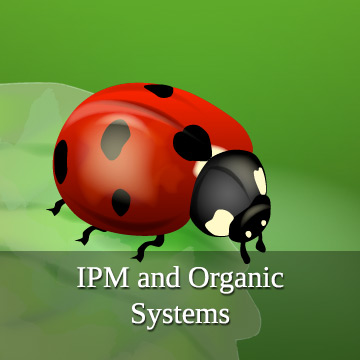
IPM and organic communities share many of the same goals as well as challenges, and have great potential to support one another and accomplish more together than what either might individually. Our Center is supporting collaboration between these two communities to build a more sustainable agricultural system in the Northeastern region and nationally. Our Center organizes meetings to bring together individuals from the IPM and organic communities including representatives from industry, nonprofit institutions, and academia. Through these partnerships, stakeholders initiate dialogue, form working groups, and engage in more formalized collaborative projects and research.
Initially, our Center partnered with Red Tomato (a nonprofit that delivers fresh, great-tasting produce while cultivating a more sustainable, ethical food system) to hold the first IPM and organic roundtable discussion in 2012 with 25 participants from across the country. Building on the earlier discussions and within an ongoing working group, our Center has formed partnerships with similar groups to maintain the conversation and collaborations. The Northeastern IPM Center staff participates in the national Organic-IPM Working Group, managed by the IPM Institute of North America, which grew from the first meeting.
It is our Center’s goal to continue to expand the number of IPM and organic researchers and practitioners working together throughout the Northeastern region. Our Center welcomes grant proposals through the Partnership Grants Program that strengthen the knowledge, “toolbox,” or audience base for both IPM and organic agriculture or that support collaborative work to address an issue with broad regional impact.
Climate Change and Pests
Contributing to the assessment of historical pest occurrences and prediction of future changes in pest distributions and the impacts on management due to climate change
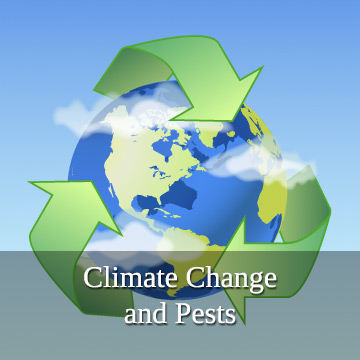
Human-induced climate change is resulting in an increase in extreme weather events and a gradual rise in average annual temperatures. The Northeast is not immune to the varied patterns in weather that are impacting both agricultural and natural ecosystems. It is not widely known what the changes in climate will mean for the distribution and occurrences of pests and little information exists as to how IPM practices will need to be tailored and what specific tools will help in addressing emerging needs.
Our Center has begun exploring ways to partner with other groups and organizations who are developing information for basic understanding and practical application. For example, the USDA’s Northeast Climate Hub, the Regional IPM Centers, the National Academy of Sciences, the American Society of Agronomy, and the Cornell Institute for Climate Change and Agriculture have partnered with our Center to organize a national forum with experts in climate and pest disciplines to share the latest, science-based information and strategize ways to plan policies for adaptable and resilient agriculture and forestry ecosystems that are threatened by pests related to climate change.
Our Center and partners anticipate that from the National Forum on Climate and Pests, regional frameworks will be developed to support pest management decisions that will lead to more sustainable U.S. agriculture and forestry ecosystems in changing climates. The long-term goal is to help U.S. agriculture and forestry minimize risks associated with increased severity and expansion of pest distributions resulting from climate variability. The major outcomes will be 1) new understanding of the vulnerabilities related to climate change with regard to pests in our agriculture and forestry ecosystems and 2) strategies to mitigate the effects from pests due to climate variability and develop resilient production systems.
In addition, our Center’s Partnership Grants Program provides an opportunity for Northeastern region colleagues to apply for grant funding for projects that would advance knowledge and our ability to apply IPM solutions to the challenges of climate change.
Rural and Urban IPM
Implementing IPM in agricultural environments, homes, workplaces, schools, communities, and natural areas
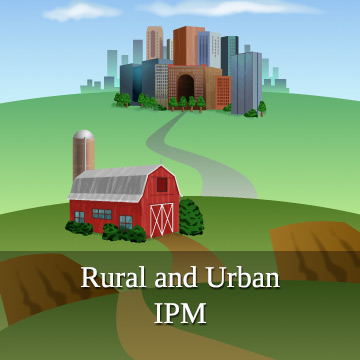
IPM works in all environments where food is produced and wherever people live, work, go to school, and recreate. In these environments, pests, including traditional and many invasive and emerging species bring adverse effects, either through lower quality food, loss of biodiversity, unhealthy conditions, or reduced integrity of the built environment. A safe and nutritious food supply that is accessible by local residents and reduces harmful and excessive inputs is increasingly important for sustaining communities. Using IPM methods, growers can protect human health as well as that of the environment.
One large project that our Center is integrally involved in is the biology, ecology, and management of the brown marmorated stink bug (BMSB). The brown marmorated stink bug is a voracious pest that was unintentionally introduced to the northeastern United States in the 1990s. It has quickly become a major agricultural and nuisance pest and continues to spread throughout the United States. It feeds on a long list of crops with damages estimated at $37 million to the mid-Atlantic apple industry alone. In partnership with scientists and researchers across the country, our Center is helping to communicate their work in developing IPM solutions to help control this pest and reduce its impacts. Our Center created and now maintains the website for this national project at www.stopbmsb.org.
Another effort that our Center is leading is the improvement of pest control in affordable housing through the project “Promoting IPM in Affordable Housing,” which teaches managers, maintenance staff, and residents how to use IPM. Efforts are centered on eliminating obstacles to using IPM in affordable housing and refining an implementation process for housing providers. Indoor pests, including molds, common insects such as cockroaches and bed bugs, and rodents can contribute to health issues. In addition to providing hands-on training, our Center created a website, www.stoppests.org, to share IPM solutions and resources to help people take control of their pest management.
Our Center will continue to broaden its efforts in rural and urban settings. Partnerships will continue to be developed with building managers, grower groups, retailers supplying resources for pest management, and government organizations. Networks and bridges will be built between rural and urban communities, placing a priority on communication and embracing technological advances that help propel project results into field implementation. The participation of regional and local partners together will be encouraged in workshops and presentations on local and regional issues that may include invasive and emerging species, pesticide resistance, and other pest threats to sustaining rural and urban communities.
Next Generation Education
Developing IPM training and educational opportunities on a variety of platforms for professionals and students of all levels
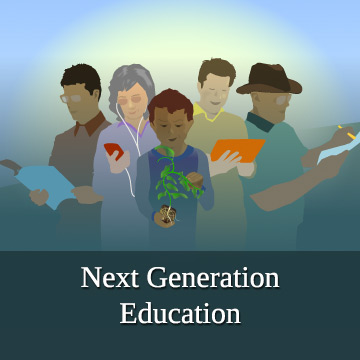
Our Center recognizes the need to train IPM scientists, educators, and practitioners. It is critical to maintaining the IPM knowledge base that there are trained individuals who understand IPM basics, whether students or professionals or those from other fields. Our Center, in partnership with individuals in academia, aims to educate students, both young and old, in IPM through online and face-to-face, hands-on courses, and through research and extension projects. An invaluable component of education at the undergraduate level is the internship. Our Center is capable of advising students on internship projects that provide real-world experience and allow for partnerships to be built with growers, educators, researchers, and industries who will want to work with these interns and possibly employ them post-graduation.
One example of our Center’s work in this area is the collaborative effort with each state IPM coordinator in the 12-state region to develop an undergraduate IPM training program for the Northeast. The goal is to create the infrastructure to train highly-motivated and talented undergraduate students in the fundamentals of IPM so that they build the skills necessary for graduate study or an academic, business, or government career. The objectives are to 1) provide hands-on experience with IPM practices at non-land and land grant institutions throughout the Northeast; 2) train undergraduate students in the field of IPM to equip them with the knowledge to join the agricultural and pest management workforce, or pursue undergraduate and graduate studies with confidence and vital skills; and 3) provide undergraduate students with strong mentoring, research, and extension experiences to ensure their success at the next level.
Our Center works to provide training and education directly through projects, such as StopPests, or indirectly by exhibiting at conferences or co-sponsoring a poster session at a meeting, such as the International IPM Symposium. Our Center has organized sessions on cutting-edge topics, such as advanced technology, put together training material on the brown marmorated stink bug, and then posted the videos on YouTube. The platforms for educating elementary students to professionals ranges from workshops with lectures to online, interactive webinars to conference calls. With continued development of communication tools, our Center will be taking the lead in incorporating the latest and most effective into our teaching and education.
Advanced Production Systems
Promoting the use of technology to implement IPM in diverse and alternative production systems
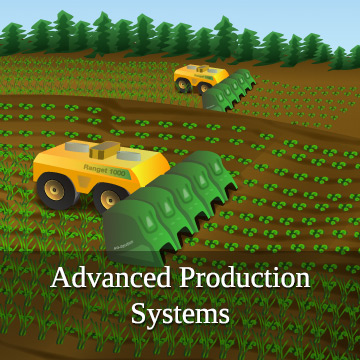
Food production systems are changing with technology. The principles of precision agriculture are being used not only in crop fields, but in vertical skyscraper farming, rooftop gardens, and high-tech greenhouses, yet none are exempt from pests. Regardless of whether organic, conventional, or sustainable, all food production systems could benefit from the incorporation of automation, sensors, and micro-scale technologies to better apply IPM.
In the United States, production agriculture is contributing to meeting the needs of a growing population, but the methods for growing food must get better faster or there could be a significant shortfall. One way to do this is by being more precise in the management of pests, which will result in increased production, lower inputs, and reduced environmental contamination that in many ways is more sustainable. Whether weeds, insects, diseases, or other pests, technologically advanced equipment can now identify pests even before they become a threat.
In urban or enclosed food production systems, technology could be used not only to identify and control individual pests, but prevent their entrance using sophisticated devices, such as electronic noses that detect volatiles released by pathogens, acoustic detectors for identifying insects, and portable PCR units for real-time identification of fungal, bacterial, and viral diseases.
Our Center is keeping up with the latest developments in advanced production systems and sharing information through organized sessions, articles, and conference presentations. Our Center is interested in adding fundable projects to broaden one of the most rapidly changing Signature Programs that requires a high level of “outside-the-box” thinking.
